|
Sunday:
August 3, 2003 | |
0001 GMT |
 |
Further delay ordered for Delta 4 rocket launch
Launch of the Boeing Delta 4 rocket carrying the DSCS 3-B6 communications satellite for the U.S. military is being delayed a few more days so workers can replace an antenna on the vehicle's safety-destruct system. A new launch date has not been established.
 MISSION STATUS CENTER - updates! MISSION STATUS CENTER - updates!
 |  |
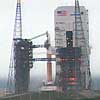
|
 |
Deeply embedded stellar clusters found in Milky Way
Peering into a giant molecular cloud in the Milky Way galaxy astronomers from the European Southern Observatory have discovered a whole new population of very massive newborn stars.
 FULL STORY FULL STORY
 |  |
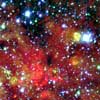
|
 |
Search for life could include planets, stars unlike ours
The search for life on other planets could soon extend to solar systems that are very different from our own, according to a new study by an Ohio State University astronomer and his colleagues.
 FULL STORY FULL STORY
 |  |

|
 |
|
Saturday:
August 2, 2003 | |
0017 GMT |
 |
Delta 4 rocket could launch Monday, pending tests
Engineers were expected to complete a series of tests Friday night on thermal protection material used by the Boeing Delta 4 rocket, giving senior officials the data to decide if launch can occur Monday evening from Cape Canaveral.
 MISSION STATUS CENTER MISSION STATUS CENTER
 |  |

|
 |
Stratosphere's role in weather suggested
What happens in the stratosphere, the atmospheric layer just above where commercial airplanes fly, may have a larger influence on our climate and weather than previously thought, according to research funded by NASA, NOAA and the National Science Foundation.
 FULL STORY FULL STORY
 |  |

|
 |
|
Friday:
August 1, 2003 | |
0109 GMT |
 |
Delta 4 launch delayed
Sunday's scheduled launch of the Boeing Delta 4 rocket from Cape Canaveral is being delayed 24 hours to give engineers time to complete tests of thermal protection material on the vehicle. Liftoff is tentatively reset for Monday.
 MISSION STATUS CENTER MISSION STATUS CENTER
 |  |
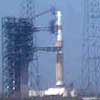
|
 |
Mars orbiter captures view of stair-stepped mound
This Mars Global Surveyor image shows a stair-stepped mound of sedimentary rock on the floor of a large impact crater in western Arabia Terra.
 FULL STORY FULL STORY
 |  |

|
 |
Spacecraft confirm expected ozone recovery
NASA satellite observations have provided the first evidence the rate of ozone depletion in the Earth's upper atmosphere is decreasing. This may indicate the first stage of ozone layer recovery.
 FULL STORY FULL STORY
 |  |

|
 |
|
Thursday:
July 31, 2003 | |
0343 GMT |
 |
Ion engine records nearly five years of firing time
The future is here for spacecraft propulsion and the trouble-free engine performance that every vehicle operator would like, achieved by an ion engine running for a record 30,352 hours at NASA's Jet Propulsion Laboratory. The engine is a spare of the Deep Space 1 ion engine used during a successful technology demonstration mission.
 FULL STORY FULL STORY
 |  |
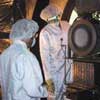
|
 |
Columbia board: NASA needs better imaging
The Columbia Accident Investigation Board has issued its fifth preliminary finding and recommendation to the National Aeronautics and Space Administration, in advance of its appearance in the final report.
 FULL STORY FULL STORY
 |  |

|
 |
Close encounters of the stellar kind
NASA's Chandra X-ray Observatory has confirmed that close encounters between stars form X-ray emitting, double-star systems in dense globular star clusters. These X-ray binaries have a different birth process than their cousins outside globular clusters, and should have a profound influence on the cluster's evolution.
 FULL STORY FULL STORY
 |  |
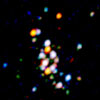
|
 |
Antarctic telescope delivers first neutrino sky map
A novel telescope that uses the Antarctic ice sheet as its window to the cosmos has produced the first map of the high-energy neutrino sky. The map provides astronomers with their first tantalizing glimpse of very high-energy neutrinos, ghostly particles that are believed to emanate from some of the most violent events in the universe -- crashing black holes, gamma ray bursts, and the violent cores of distant galaxies.
 FULL STORY FULL STORY
 |  |
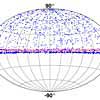
|
 |
|
Wednesday:
July 30, 2003 | |
0143 GMT |
 |
300th Delta to launch last Air Force DSCS satellite
This weekend's launch from Cape Canaveral will mark a moment in history for the Delta rocket and the finale for a long-running family of U.S. military communications satellites.
 FULL STORY FULL STORY
 LAUNCH TIMELINE LAUNCH TIMELINE
 GROUND TRACK MAP GROUND TRACK MAP
 |  |

|
 |
The future: Air Force EELV launch schedule
The upcoming Delta 4 rocket flight carrying the last DSCS satellite marks the second Air Force Evolved Expendable Launch Vehicle mission. For a look into the future, we present this EELV launch schedule. It shows the next 26 Air Force flights of Delta 4 and Atlas 5, the payloads and launch sites, and notes which missions were transferred to Lockheed Martin as the Air Force's penalty against Boeing for wrongdoing.
 LAUNCH SCHEDULE LAUNCH SCHEDULE
 |  |

|
 |
X-37 demonstrator completes structural tests
An approach and landing test version of the X-37, a spacecraft designed to demonstrate technologies for NASA's Orbital Space Plane Program, has successfully completed structural testing in Huntington Beach, Calif.
 FULL STORY FULL STORY
 |  |

|
 |
|
Tuesday:
July 29, 2003 | |
0153 GMT |
 |
New maps of Mars water
"Breathtaking" new maps of likely sites of water on Mars showcase their association with geologic features such as Vallis Marineris, the largest canyon in the solar system. The maps detail the distribution of water-equivalent hydrogen as revealed by Los Alamos National Laboratory-developed instruments aboard NASA's Mars Odyssey spacecraft.
 FULL STORY FULL STORY
 MARS NEWS ARCHIVE MARS NEWS ARCHIVE
 |  |

|
 |
Wind and reflections from supermassive black hole
This composite image of the active galaxy, NGC 1068, shows gas blowing away in a high-speed wind from the vicinity of a central supermassive black hole. The elongated shape of the gas cloud is thought to be due to the funneling effect of a torus, or doughnut-shaped cloud, of cool gas and dust that surrounds the black hole.
 FULL STORY FULL STORY
 |  |

|
 |
|
Monday:
July 28, 2003 | |
0258 GMT |
 |
Troubles strike Landsat 7
Officials with the Landsat 7 Earth-watching satellite program have now spent almost two months struggling with a problem that significantly degrades the scientific value of images from the observatory.
 FULL STORY FULL STORY
 |  |
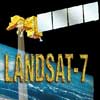
|
 |
Intriguing celestial images arrive from GALEX
NASA's Galaxy Evolution Explorer has beamed back revealing images of hundreds of galaxies to expectant astronomers, providing the first batch of data on star formation that they had hoped for.
 FULL STORY FULL STORY
 |  |
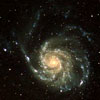
|
 |

